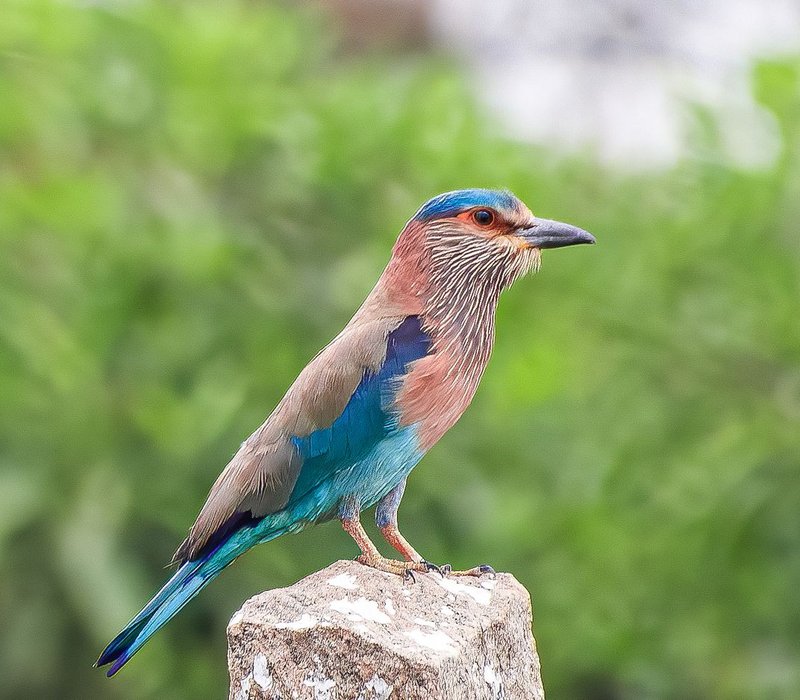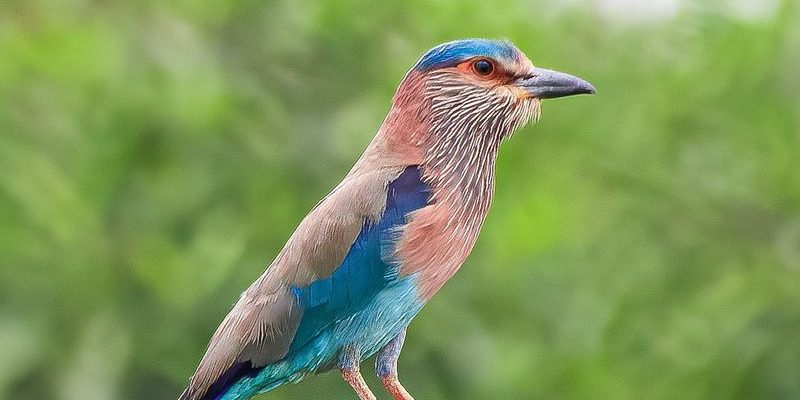
The Indian Roller is not just a bird; it’s an explosion of color that brings life to the skies of South Asia. Imagine a painter’s palette—brilliant blues, vibrant greens, and earthy browns coming together in a stunning display. When you spot an Indian Roller soaring overhead, it’s hard not to feel a sense of wonder. These birds are known for their acrobatic flight and striking appearance, making them a favorite among birdwatchers and nature enthusiasts alike.
So, what makes the Indian Roller so special? Aside from its gorgeous colors, this bird has fascinating behaviors and habits that set it apart from other avian species. As we journey through the details of the Indian Roller, you’ll find out about its habitat, diet, and even some quirky traits. If you’re curious about these beautiful birds, you’re in for a treat!
Physical Characteristics of the Indian Roller
The Indian Roller is a medium-sized bird, measuring about 24 to 26 centimeters in length. One glance at its stunning plumage tells you this bird is unique. Its head and underparts are a lovely shade of brown, while its wings and back boast a spectacular range of blues and greens. When in flight, the contrast is breathtaking. You might even catch a glimpse of its vibrant turquoise feathers flashing in the sun. Isn’t nature amazing?
These birds have a sturdy body and a relatively long tail, which helps them during their aerial displays. They are often seen gliding gracefully through the air, showcasing their beauty and agility. Their beaks are strong and pointed, perfect for catching insects and small prey. But here’s a fun fact: the Indian Roller has a unique way of rolling and diving during flight, which not only looks spectacular but is also a part of their courtship display. Talk about putting on a show!
Habitat and Distribution
The Indian Roller thrives in a variety of environments, from open grasslands to wooded areas. You can often spot them perched on trees, utility wires, or even fence posts, scanning the ground for food. Their adaptability allows them to live in regions across South Asia, including India, Pakistan, and Bangladesh. If you’re traveling through these areas, keep your eyes peeled—you might just see one of these colorful birds within arm’s reach!
During the breeding season, you’ll find them preferring habitats with more cover, as they seek safety for their nests. They usually lay their eggs in tree cavities or old buildings, a clever way to protect their future chicks. Once you understand their habitat preferences, spotting these beautiful birds becomes easier—and it’s certainly worth the effort!
Diet of the Indian Roller
Now, let’s talk about what the Indian Roller eats. These birds are primarily insectivores, meaning they chow down on a variety of insects like grasshoppers, beetles, and crickets. They have excellent eyesight, which helps them spot their prey from a great distance. When hunting, they often swoop down from their perch, catching their meal mid-air or snatching it off the ground. It’s a fascinating sight to witness!
In addition to insects, Indian Rollers will also eat small reptiles and rodents if they have the chance. Their versatile diet means they can thrive in different environments, allowing them to adapt to seasonal changes in food availability. If you watch closely, you may catch them performing their impressive aerial displays while searching for dinner. Who doesn’t enjoy a dinner and a show?
| Characteristic | Details |
| Size | 24–26 cm in length |
| Coloration | Bright blue and green wings, brown head and underparts |
| Habitat | Open grasslands, wooded areas, near human settlements |
| Diet | Insects, small reptiles, rodents |
| Flight Behavior | Acrobatic with rolling dives during displays |
| Breeding Season | Spring to summer |
| Conservation Status | Least concern |
Breeding and Nesting Habits
The breeding season for the Indian Roller typically occurs between March and August, aligning with the warm months when food is plentiful. During courtship, the males put on impressive aerial displays, rolling and diving through the air to attract a mate. Watching this performance can be nothing short of mesmerizing, as the male showcases his strength and agility, hoping to win the heart of a female.
Nesting usually takes place in tree cavities or abandoned structures, providing the safety needed for the eggs. The female lays about 3 to 5 eggs, which are incubated for around 15 days. Once the chicks hatch, both parents share the responsibility of feeding and protecting them. This teamwork is vital, ensuring the young have the best chance of survival. Isn’t it sweet to see parental care in action?
Behavior and Social Structure
The Indian Roller is generally social and often seen in pairs or small groups. They communicate with a variety of calls, including soft chattering sounds and loud caws. These calls can serve different purposes, like establishing territory or alerting others to potential threats. While they can be quite vocal, they also have a calm demeanor, often enjoying long periods of quiet while they perch and observe their surroundings.
Interestingly, Indian Rollers are known to be quite tolerant of humans. They often nest close to human habitations, taking advantage of available nesting sites. This unique relationship allows bird watchers to enjoy observing them in their natural habitat without too much disturbance. So, if you’re lucky enough to live near these beautiful birds, consider yourself fortunate! You might have a front-row seat to one of nature’s colorful performances.
Conservation Status
Fortunately, the Indian Roller is classified as “Least Concern” by the IUCN, meaning they are not currently facing significant threats to their population. However, habitat loss due to urbanization and agricultural practices can pose risks in certain areas. It’s essential to monitor their habitats and ensure they have the environments needed for breeding and feeding. Conservation efforts, including preserving grasslands and wooded areas, play a crucial role in keeping these beautiful birds thriving.
As a nature lover, you can contribute to conservation efforts by supporting local wildlife organizations or advocating for the protection of natural habitats. Every little bit helps in ensuring that future generations can enjoy the sight of Indian Rollers soaring through the sky.
The Indian Roller is a stunning example of nature’s artistry. With its vivid colors and captivating behaviors, it’s no wonder they hold a special place in the hearts of bird enthusiasts. Whether you’re spotting them in the wild or learning about their habits, there’s much to appreciate about these remarkable birds. So, the next time you see an Indian Roller, take a moment to enjoy the beauty and grace they bring to our world!
FAQ
What is the lifespan of an Indian Roller?
The lifespan of an Indian Roller in the wild typically ranges from 5 to 10 years, depending on environmental conditions and threats from predators. However, individual birds may live longer if they have access to food and shelter, and face fewer dangers. Observing these birds in a controlled environment can also provide insights into their longevity.
Are Indian Rollers migratory birds?
Indian Rollers are not considered migratory in the traditional sense. They tend to remain in their habitats year-round, although some populations may move short distances in response to seasonal changes in food availability. This behavior allows them to adapt to varying environmental conditions while still maintaining their familiar territories.
What do Indian Rollers symbolize in culture?
In various cultures, Indian Rollers are often associated with good fortune and joy. Their vibrant colors and joyful presence have made them a symbol of positivity in some regions. In India, they are even considered auspicious and are linked to celebrations, especially during weddings and festivals.
How can I attract Indian Rollers to my backyard?
If you want to attract Indian Rollers to your backyard, providing a suitable environment is key. Planting native trees and shrubs can create a welcoming habitat. Additionally, offering a water source like a birdbath can draw them in, as they need water for drinking and bathing. Being mindful of pesticide use will also create a healthier environment for these birds, allowing them to thrive.
Do Indian Rollers have any natural predators?
Yes, Indian Rollers face threats from various predators, including larger birds, mammals, and reptiles. Young or injured birds are particularly vulnerable. Ensuring a safe nesting environment helps reduce the risks, as does having plenty of cover to escape from potential threats.
How do Indian Rollers communicate?
Indian Rollers communicate through a series of vocalizations, including soft chattering calls and loud caws. They use these sounds to establish territory, attract mates, and notify each other of danger. The complexity of their calls reflects their social nature and the need for interaction within their groups.
What time of day are Indian Rollers most active?
Indian Rollers are typically diurnal, meaning they are most active during the day. You’ll likely see them engaging in hunting and social behaviors in the early morning and late afternoon when temperatures are cooler. These times are also perfect for birdwatching, as they are more visible and active.
Do Indian Rollers play a role in the ecosystem?
Absolutely! Indian Rollers play an important role in the ecosystem by controlling insect populations through their diet of various insects. By keeping these populations in check, they help maintain a balance within their environment, showcasing the interconnectedness of nature.
Can I find Indian Rollers in urban areas?
Yes, Indian Rollers are quite adaptable and can often be found in urban areas. They are frequently seen perching on power lines, trees, and gardens, taking advantage of available food resources. Their tolerance of human presence allows birdwatchers to enjoy their beauty even in bustling cities.
What is the best time of year to see Indian Rollers?
The best time to see Indian Rollers is during the warmer months, particularly in spring and summer. This is when they are most active in breeding, and you’ll witness their stunning courtship displays. Whether you’re an avid birdwatcher or just curious, this is an ideal time to spot these stunning birds in the wild.

